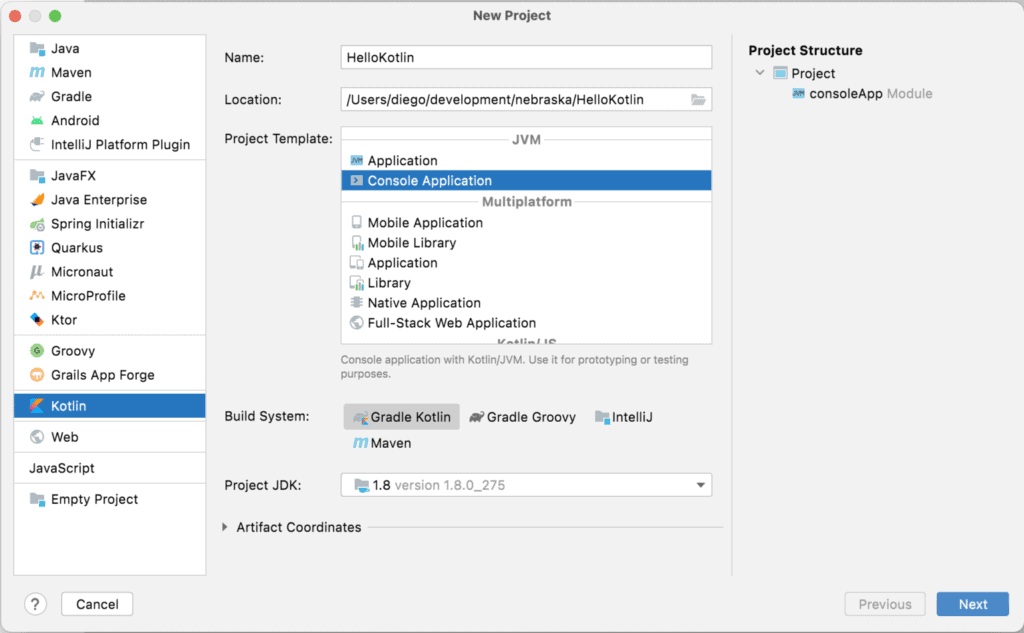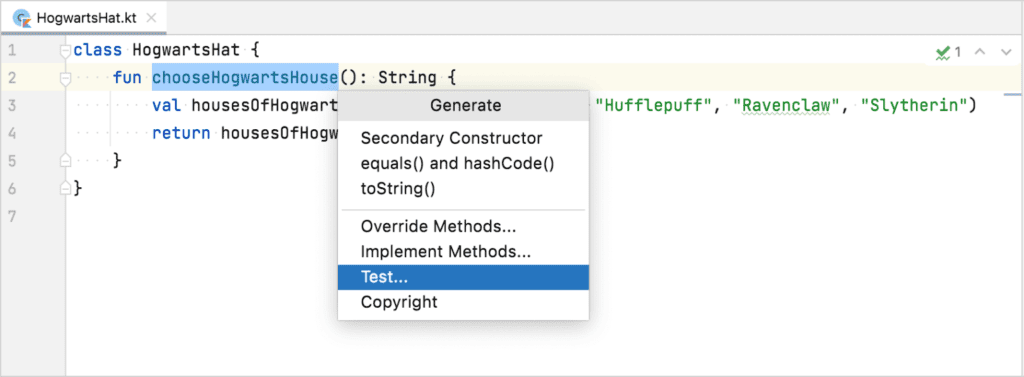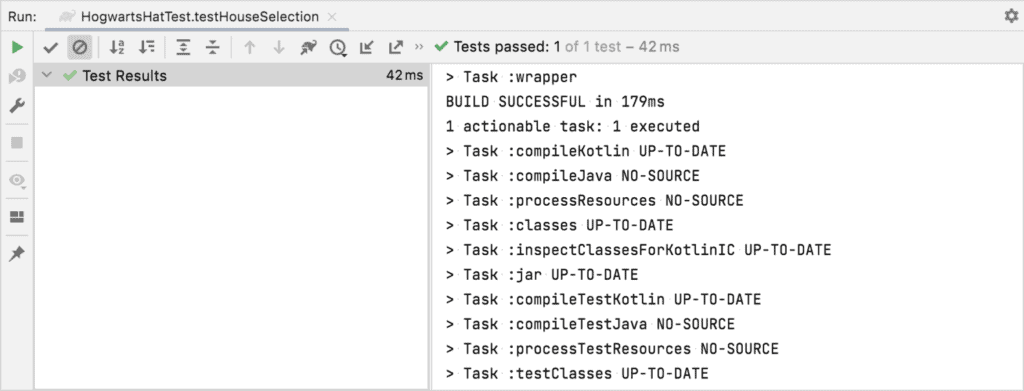1. 概述
IntelliJ IDEA 是 Java 生态中最主流的 IDE 之一。如果你打算使用 Kotlin 开发应用,IntelliJ 是首选工具,因为它对 Kotlin 有原生支持,开发体验非常流畅。
本文将介绍如何使用 IntelliJ IDEA 快速开始 Kotlin 开发。
2. 安装与创建项目
2.1. 下载并安装 IntelliJ IDEA
首先,访问 IntelliJ 官网 下载适用于你操作系统的最新版本(Windows、Linux、macOS 均支持)。
安装完成后,IDE 自带运行 Kotlin 应用所需的所有运行时环境。
2.2. 创建 Kotlin 项目
打开 IntelliJ,执行以下步骤创建一个 Kotlin 控制台项目:
- 点击
File > New > Project - 左侧选择
Kotlin,然后选择Console Application模板 - 点击
Next,确认使用 JDK 1.8(或更高) - 构建工具默认使用 Gradle,测试框架默认是 JUnit 4
- 点击
Finish完成创建

IntelliJ 会自动生成项目结构,并配置好 build.gradle.kts 文件中的依赖。
2.3. 自定义项目代码
创建完成后,项目中会生成一个 main.kt 文件,位于 src/main/kotlin 目录下。
默认生成的代码如下:
fun main(args: Array<String>) {
println("Hello World!")
}
我们可以修改为一个更有趣的例子:模拟霍格沃茨分院帽随机分配学院:
fun main() {
val housesOfHogwarts = arrayOf("Gryffindor", "Hufflepuff", "Ravenclaw", "Slytherin")
val houseSelected = housesOfHogwarts.random()
println("Congratulations! You have been selected to belong to the house of $houseSelected!")
}
2.4. 运行程序
点击编辑器左侧的绿色运行按钮 ▶️,选择 Run MainKt 即可运行程序。

运行结果会显示在控制台:

✅ 至此,你的第一个 Kotlin 应用已经运行成功!
3. 编写单元测试
3.1. 配置测试依赖
IntelliJ 默认已为你配置好测试依赖。如果没有,可以在 build.gradle.kts 中添加以下内容:
dependencies {
testImplementation(kotlin("test"))
}
tasks.test {
useJUnit()
}
3.2. 创建测试类
我们将逻辑封装进一个类中,而不是直接写在 main 函数里:
class HogwartsHat {
fun chooseHouse(): String {
val housesOfHogwarts = arrayOf("Gryffindor", "Hufflepuff", "Ravenclaw", "Slytherin")
return housesOfHogwarts.random()
}
}
接着,点击菜单 Code > Generate > Test...,选择 HogwartsHat 类,生成测试类。

生成的测试类位于 src/test/kotlin 目录下:
class HogwartsHatTest {
private val hogwartsHat: HogwartsHat = HogwartsHat()
@Test
fun testHouseSelection() {
val hogwartsHouse = hogwartsHat.chooseHouse()
assertNotNull(hogwartsHouse)
assertTrue { arrayOf("Gryffindor", "Hufflepuff", "Ravenclaw", "Slytherin").contains(hogwartsHouse) }
}
}
3.3. 执行测试
点击测试方法左侧的运行按钮 ▶️,选择 Run HogwartsHatTest,即可执行测试。

✅ 测试通过后,表示你的测试逻辑没有问题。
4. 总结
本文介绍了如何使用 IntelliJ IDEA 快速创建 Kotlin 项目、运行程序以及编写基本的单元测试。
✅ IntelliJ 提供了非常完善的 Kotlin 开发工具链,极大简化了开发流程。
如果你是 Java 开发者,转向 Kotlin 将非常自然,且能获得更简洁、安全的代码体验。
⚠️ 踩坑提示:记得测试依赖是否正确配置,否则测试无法运行。